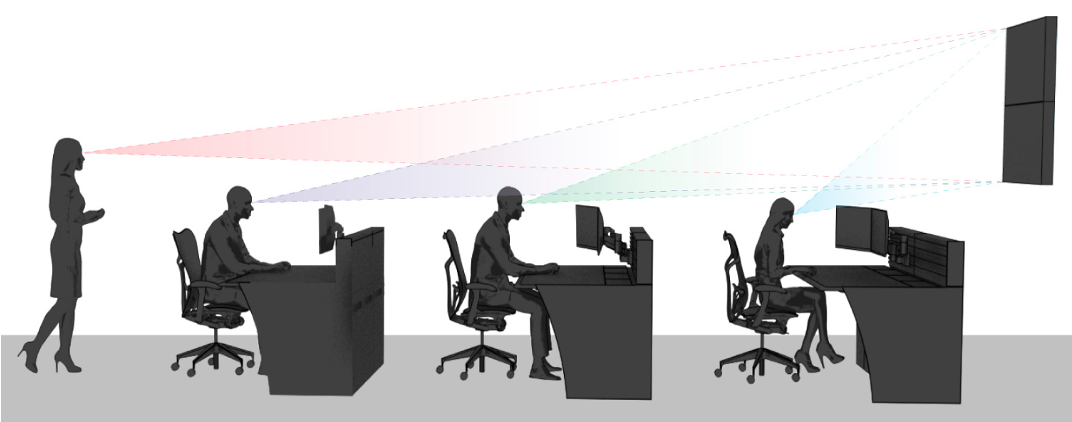Operations Centre Design
There is real value in having a dedicated physical space where a core team can operate as the focal point for the coordination of distributed teams. Getting key operational functions working together in close proximity is already a silo-busting achievement. However, when using an operations centre for long periods of time there are some important design considerations to consider.
Room dimensions
The space must be fit for purpose, whether it is newly built or an existing location. It should accommodate the planned seating capacity for any expansion for longer-term use. High ceilings are needed for full visibility of video walls. Long narrow spaces should be avoided to allow for better horizontal visibility across the room and video walls.
2. Seating layout
The seating layout is dependent on room dimensions. Options include front-facing, circular, v-formation, work pods and combinations of these. There are trade-offs to be made on team co-location, video wall visibility and space utilisation. Team collaboration should be a driving principle in the design, clustering similar functional teams as much as possible. The design may change over time based on lessons learned and evolving operational needs.
3. Personal workspaces
A standard desk is 1.2m x 0.75m. Anything smaller than that will make for an uncomfortable working environment. Consideration should also be made to provide separation between workspaces, especially for long-term operations. This is where people will spend a lot of time, so they need to be comfortable and have some individual working space to concentrate. High-quality chairs and adjustable tables also improve ergonomics.

4. Workspace equipment
Some ops centre roles may require multiple displays or a high-quality ultrawide, but likely not all. Will people bring their own laptops, or will there be dedicated workstations for each position? Quality headsets enable people to focus, without external distractions.
5. Passageways
Sufficient space is needed behind individual working spaces. For example, in low-traffic areas around 0.6m is needed behind a personal workspace and for high-traffic areas, around 0.9m.
6. Video wall
The purpose of a video wall is to provide real-time, shared operational visibility to those in the room. While people can see everything they need on a laptop or mobile, the video wall is helpful when anyone (and everyone) can see a change in operational status out of the corner of their eye (e.g. green to red service status, it started raining, excessive crowding, etc). The video wall(s) need to match the room design and there are multiple options including LED, flat-screen TV and high-res projection each with pros and cons. Some important considerations include viewing distance, viewing angles, minimum height (above eye obstruction line), total wall height and the breakup into sections horizontally based on functional needs.

7. Access control
Controlled access is typically required to limit who can access and log entry and exit.
8. External visibility
The operations centre may be visible (via a glass wall or viewing area) to those on the outside, or it may be closed off if dealing with highly confidential information.
Adjustable blinds or smartglass is a good way to have the best of both.
In reality, whether we like it or not, most operations centres have a showcase role at times.
9. Lighting
Adjustable lighting that can control lights individually and by group provides better flexibility for different times of the day and purposes. Consider personal lamps for each desk as overall lighting levels in the room may be lowered at times.
10. Audio / Sound
Noise levels should not exceed 55 dB(A) to enable the team to maintain focus. A normal conversation is approximately 60 dB (A). Consider the use of flexible tools to improve acoustics such as quality wireless headsets and workspace dividers. In large spaces, a microphone and speaker system is needed for briefings and updates.
11. Cabling
A raised floor with redundant cabling provided for each working space to save time in case of cable failure. Plan the power and data sockets in a desk surface with proper cable management, with a guarantee of quick access to the wiring.
12. HVAC
Cooling capacity needs to consider the heat from the video wall (if using LED / flat screen TV). Air quality (including CO2 level) and air temperature play an important role in keeping people alert. For optimal comfort, room temperature would range from 22 to 24 degrees Celsius, with relative humidity from 40 to 65 per cent. The CO2 level recommended: is 500 – 1000 ppm and an environmental sensor should be installed to measure the above.
13. Power
Reliable power source provided. UPS & backup power should be provided.
14. Security
Fire alarm to be installed & CCTV as needed.
15. Telecommunications
Ideally use two independent providers with geographically diverse entrances to the building and cable paths to critical network equipment.
16. Alternate (Backup) ops centre
What is the alternative location to be used for the team in case of disaster (flood, fire) in main operations space?
17. Supporting rooms
Supporting the operations centre may be additional rooms used for major incident / crisis management, side meetings, executive briefings and possibly satellite operations capabilities. These should be considered based on needs.